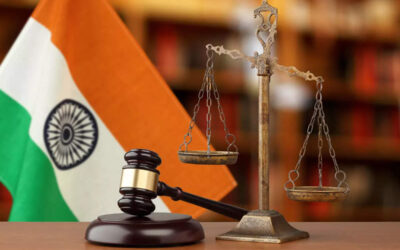
INTRODUCTION
1.1 Technology & arbitration were never born for a fling but for a lifelong relationship which has an untapped potential to establish a stable & confident community. Both of these aim for dynamism & continuously adapt themselves to the need of the hour. These enjoy common attributes such as speed, reliability and flexibility. These are the most desirable guardians of social & commercial evolution.
1.2 On one hand, the arbitration mechanism aims to provide faster dispute resolution and on the other hand, technology is continuously evolving towards automation beyond human capabilities, and hence, more the synergy, better shall be the value delivery.
1.3 Going by the strict interpretation of the word “technology” the same shall include electronics to health or biotechnology however the most suitable technology type in the context of arbitration shall predominantly remain information technology and its advancement in the form of artificial intelligence.
1.4 The concept of effective usage of information technology becomes more significant and challenging when the requirements of international arbitration are aimed. The advancement of communication & electronic transmission of data are so significant in our personal life today that the same cannot be ignored in an international arbitration wherein time & place becomes the biggest challenge financially.
1.5 A comprehensive technological action in the right direction can not only overcome the present challenges in arbitration, but can also create a global infrastructure of dispute resolution that in turn can ensure more confident commercial transactions between nations.
ECOSYSTEM & BARRIERS
2.1 Before we discuss the future, let us make a quick review of the present usage of technology in arbitration. Some of the common usages include:
- E-mails for communication & exchange of information
- Storage media to preserve digital information or documents
- Display devices to present & exchange information on real-time basis
- Multipurpose software such as video conferencing, database & case management
It is pertinent to mention that above quoted technological adaptations have highly facilitated the arbitration proceedings in terms of not just its management but better reliability & ease of transaction.
2.2 The present scenario in terms of technological interphase in arbitration is highly progressive and parties are slowly and steadily experiencing the advantages associated with the adaptation of technology. However, there is a significant level of hesitation & resistance due to following reasons:
- Lack of experience and training with IT systems & its troubleshooting mechanism
- Absence of absolute integrity due to software errors, system manipulations & hacking
- Human perception & experience associated with virtual software usages
- The gaps in implementation of the IT systems in the existing arbitration framework
- Mindset of present practitioners & their will to adapt the IT systems
- Absence of recognition to IT usage in statutory international conventions that govern the arbitration process globally
2.3 It is a highly probable scenario in a virtual session that a party which is uncomfortable at a given point may try to excuse itself through software disruption or manipulation, which is almost impossible in physical hearing. The integrity of examination of a witness over a virtual environment cannot be ensured as in physically controlled environment wherein possibility of outside aid to a witness is completely eliminated.
2.4 The concept of fair trial & natural justice in accordance with law of the land makes it incumbent upon the arbitration proceedings to remain as near as possible to the court room practice and hence a significant & fast paced technological adaptation may give rise to various legal issues & objections specially by the adverse party.
EXISTING FRAMEWORKS
3.1 The UNCITRAL model law on international commercial arbitration & the international conventions on arbitration (New York & Geneva Convention) have neither recognised nor contemplated the need of IT solutions in arbitration and accordingly various countries while adopting the same has missed the inclusion of a significant technological consideration. However the inbuilt flexibility provided by the model law wherein parties, arbitration institutions & tribunals have certain level of flexibility in adopting the procedures including use of technology in accordance with the requirements & availability has ensured that the desired technological assistance can be obtained without much encumbrances.
3.2 The COVID era has pushed the institutions & organisations to embrace the IT systems and operate in virtual environments and hence in conformity with the inbuilt flexibility of adoption through mutual agreement many arbitration institutions have included usage of IT solutions in their rules for example, World Intellectual Property Organisation (WIPO) revised its rules on 1st July 2021, & London Court of International Arbitration (LCIA) revised its rules on 11th Aug 2020, to recognise and include the usage of technology specially in e-communication including virtual sessions. An effort has been made towards electronic filings and acknowledgements.
3.3 In Indian context the Indian Arbitration Forum (IAF) has issued protocol on virtual hearings for arbitrations in the month of September 2020 and the same is supported by major arbitration institutions such as MCIA, IIAC, ILSCA, BIMACC, etc. Section 24 read with section 19 (3) of The Arbitration & Conciliation Act, 1996 empowers the arbitration tribunal to order procedure of conduct of hearing & written proceedings in the absence of mutual consent of the parties and thereby empowering the tribunal to order virtual hearing. Even though the law of evidence is not applicable for arbitration but it is worth to note that in State of Maharashtra v. Praful B. Desai (AIR 2003 SC 2053) the Supreme Court decreed that evidence could now be recorded by means of video conferencing. At the same time existence of statutes such as Stamp act, 1899 & Registration Act, 1908, etc. when applied on arbitration award makes physical work mandatory and inevitable till a suitable technology solution is embraced.
EFFECTIVE ADOPTION
4.1 There is an urgent need for all stake holders & regulators to acknowledge the fact that the arbitration proceedings must adopt IT solutions on continuous basis and keep evolving. Information Technology should not just be declared complementary but a necessary element of proceedings.
4.2 A dedicated skill set must be established within arbitration fraternity preferably in the domain of techno-legal practices and the same must be standardised not only for operations but to fix the responsibility of individuals in the process. The technological solutions for arbitration proceedings must be customised or developed from baseline instead of making adaptation of existing solutions. Such adaptations cannot be a perfect match & hence the overall control is likely to remain weak.
4.3 The dynamics of IT environment must be clearly recognised, and sufficient flexibility must be ensured to cater for the changes that may come along the way without having the need to undertake elaborate procedures for amendments.
4.4 The recognition of major IT enablers in statutory acts such as electronic signatures, documents, records, delivery of service, etc and provisions for offences such as computer tampering, identity theft, violation of privacy & cyber terrorism, etc have given the much needed statutory protection to the usage of technology however the gaps leading to delayed recognition & enforcement of rights requires to be addressed on priority to reassure the users of technology. There also exists a need to make suitable provision for technical assistance of arbitral tribunal similar to section 6 of Arbitration and Conciliation Act, 1996 providing for administrative assistance including provisions for associated expenses.
FUTURE PROSPECTS
5.1 Introduction of new technologies can aid arbitration process in many innovative ways in accordance with modern life style & globalisation. Some of the possible future usages of technology are listed below:
- Specialized API interface at an arbitration institution can enable online verifications and confidential data access of government and other agency’s servers.
- Development of artificial intelligence for interpretation of documents making real-time observations and providing ready reckoner as per the specific case requirements.
- Integrated virtual facilities spread geographically ensuring integrity of the process through complete control and monitoring.
- Auto generation of statutory documents and formats or assisted generation through intelligent suggestion.
- Complete case management software that auto enforces the rules and monitors compliance by all parties to the laid down procedure including providing acknowledgements & proof of service.
- Usage of blockchain database to ensure high level integrity of sensitive data.
- Installation of high end infrastructure such as VR to bring the experience as near to reality as possible.
- Audit mechanism to continuously check the progress and prompt for shortcomings at relevant intervals.
TECHNOLOGICAL CHALLENGES
6.1 Technology makes processes fast & automated, however, it suffers few shortcomings that can be fatal for any system if not accounted and taken care of; some of the important and significant challenges introduced by technology in present context are as follows:
- Technology implementation involves capital investment in early stage itself.
- The cost of continuous protection, maintenance of redundancy and deployment of trained manpower are regular challenges.
- Overdependence on technology can be fatal in cases of system failure or a physical damage to the equipment.
- Errors & bugs are always associated with the information technology for example Y2K or millennium bug.
- It is susceptible to Viruses, Trojans, DDOS and other cyber attacks including hacking.
- Technology is very dynamic and requires constant up-gradation of both hardware and software.
- Compatibility issues during interaction with various interfaces remain continuous challenge.
- Effective training of users & staff becomes additional requirement.
RELEVANT EXAMPLES
7.1 The integration of technology with arbitration practice is inevitable. Similar successful integrations that have taken place around us are banking & taxation, wherein heavy manual procedures were successful. These were automated and taken online leading to a healthy and effective system.
7.2 The digitalisation of Aadhar & introduction of DigiLocker services are also some of the progressive steps towards better use of technology. In business environment the usage & recognition of various ERP models are clear indicators of goods of technology adoption.
CONCLUSION
8.1 Legal systems are many a time felt to be a step behind the actual social requirement at any given time whereas technology recognises future needs & generates its own demand. A synergy between both domains holds the potential to narrow this gap towards larger public good.
8.2 The user of arbitration mechanism is predominantly the commercial world. They are the forerunners of technological advancements and hence, it is the legal procedures & practices that have to make way for the fair and swift implementation of IT solutions. Once an IT solution is proved in arbitration environment, the same can then also be taken into the court room practice with higher confidence.
REFERENCES:
- wipo.int
- iccwbo.org
- aironline.in
- Information Technology Act, 2000
- Arbitration and Conciliation Act, 1996
- UNCITRAL Model Law on International Commercial Arbitration, 1985
- Convention on the Recognition and Enforcement of Foreign Arbitral Awards (New York, 1958)
- Geneva Convention 1927

